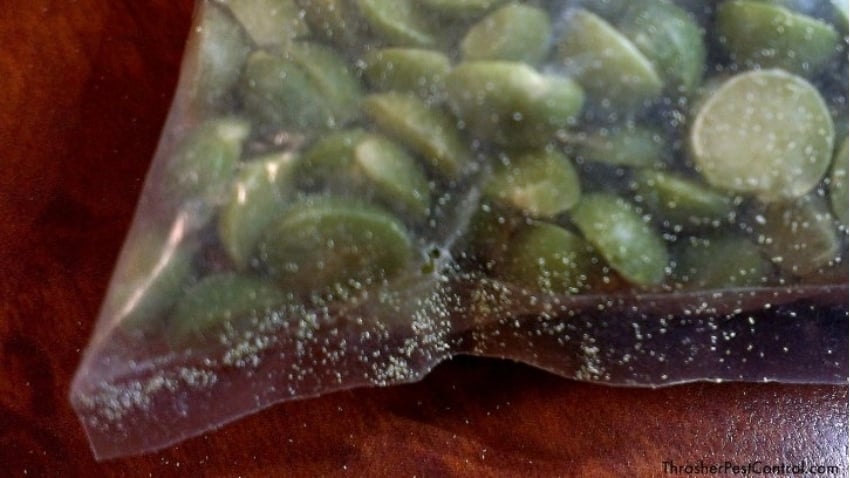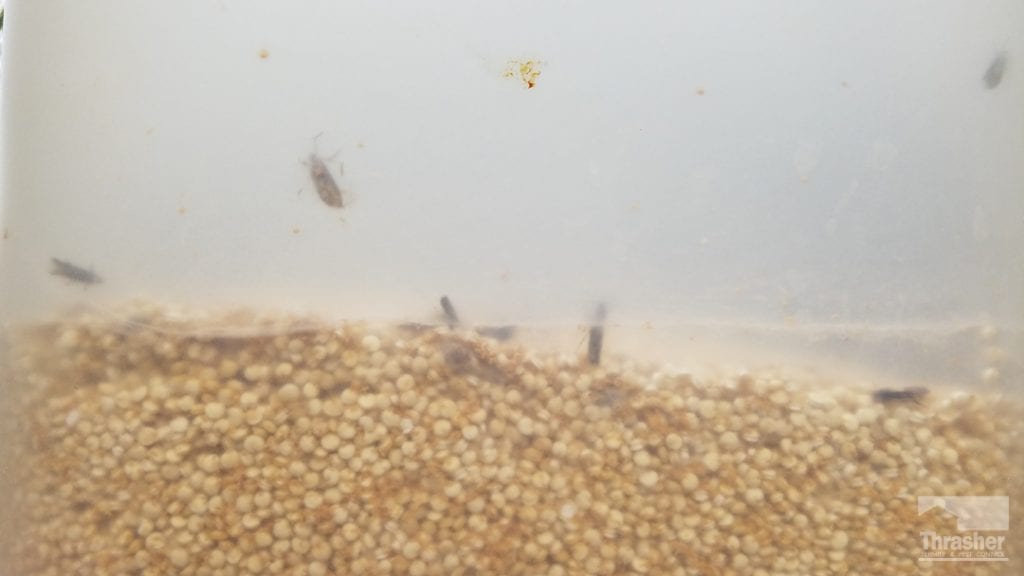- Webbing that binds flour/corn meal into clumps → discard.
- Discolored, grainy surface on dried fruit/chocolate → inspect or discard (not the same as chocolate bloom).
- Sandy, uniform pellets at the bottom of rice/bean bags = possible frass → inspect or discard.
- Pin-size holes or fragments in pasta/cereal → discard.
- Store staples in airtight containers and rotate stock (FIFO).
What are Pantry Pests?
Pantry pests, also called stored product pests and kitchen pests, are moths and beetles that feed on stored food. Think staples like flour, cereal, nuts, spices—not fresh fruit or fresh bread. Pantry pests damage food by contaminating it with their eggs, larva, and their by-products—hairs (setae), excrement, webbing, and microbes.
Frass: dry, sand-like insect droppings often found in packages or at the bottom of bags.
These are NOT pantry pests: Ants, cockroaches, mice, and rats may eat your food, but don’t live in your food like pantry pests do.
Quick Take Before You Bake
Before you open a cookbook, give ingredients a 30-second check. Flour, oats, pasta, nuts, spices, cake mixes, boxed puddings, dried fruit, spices, and chocolate chips can harbor pantry moths, beetles, weevils, or their larvae—especially when packages sit for months.
PRO TIP: measure dry ingredients into a separate bowl for inspection before you mix them with other ingredients.
Signs in Flours & Ground Goods
Products to check: wheat flour, rice flour, gluten-free flour, nut meal, masa, cornmeal, oatmeal, pudding mix, baking mix, pancake mix, and ground spices.
- Look for fluffy clumps that don’t break apart normally.
- Webbing holding clumps together = clear pantry moth activity → throw it out.
- If a lump won’t separate or looks/feels off, the product may be infested or spoiled → throw it out.

Signs in Beans, Rice & Whole Grains
Products to check: dried beans, split peas, lentils, rice, corn, quinoa, whole and steel cut oats.
- Check the bottom of bags (thin plastic can be chewed through).
- Sandy, pencil-dot sized pellets collecting at the bottom may be frass (insect droppings).
- A few broken kernels are normal; uniform, sand-like material signals pests → inspect closely or toss.
 Signs in Dried Fruit & Chocolate
Signs in Dried Fruit & Chocolate
Products to check: raisins, dates, figs, other dried fruit, bakers’ chocolate, white chocolate, chocolate chips, raw honeycomb.
- Look for discoloration, but not all discoloration is a pest problem.
- Chocolate bloom (whitish film on chocolate) = storage issue, not insects.
- Discolored, grainy surfaces can indicate feeding → inspect or toss.
- Webbing, holes, pupae, insect fragments → toss.
Signs in Pasta & Cereals
Products to check: pasta, couscous, breakfast cereal, granola, tapioca pearls.
- Discoloration, small holes, webbing, or insect fragments → toss.
- Check bottom of cardboard containers for small particles gummed to the bottom with webbing → toss.
What to Do If You Find Pantry Pests (Toss, Clean, Prevent)
- Toss: Seal and discard infested items outdoors.
- Freeze: Freeze at 0°F (−18°C) for 4–7 days to kill eggs/larvae in borderline items.
- Clean: Vacuum shelves, seams, and corners; wipe down the entire interior of cabinets and drawers with white vinegar or mild soap and dry completely.
- Seal: Store grains, flours, pasta, dried fruit, nuts, spices, chocolate, and pet food in airtight glass or thick plastic containers. Store infrequently used food items in the refrigerator to maintain freshness and avoid pests.
- Prevent: Buy smaller sizes, rotate stock (FIFO), and check packages before storing. If you purchase from bulk bins, don’t add new purchases to existing containers. Start fresh.
Pantry moth webbing that binds flour into clumps is a reliable sign of infestation.Pantry Pest Glossary (Quick IDs)
Webbing: Fine silk threads that bind flour or cereal into clumps—common with pantry moth larvae.
Frass: Pencil-dot-sized pellets or gritty material that can resemble sand at the bottom of bags.
Setae: Fine hairs/bristles on larvae; may appear on surfaces where larvae crawl.
Larva vs. Pupa: Larva = worm-like stage feeding in packages; pupa = resting stage in a cocoon on seams or corners.
Chocolate bloom ≠ insects: Whitish or gray film on chocolate from fat/sugar crystals—not a pest sign.
| DO | DON'T |
| Freeze borderline items 4–7 days at 0°F | Keep questionable items at room temp |
| Vacuum shelf seams and corners | Just wipe—eggs can remain in cracks |
| Use airtight glass/thick plastic | Rely on original packaging |
| Rotate stock (FIFO) | Store bulk goods for months |
FAQ
What does pantry moth webbing look like?
Fine, silky threads that bind flour or cereal into clumps; you may also see tiny caterpillar-like larvae or pupae.
Is the sandy material at the bottom of a rice bag normal?
A few broken grains are normal. Uniform, pencil-dot sized material can be frass (insect droppings) and suggest an infestation.
Can I eat food after freezing it to kill eggs?
Freezing can kill eggs and larvae, but if you see webbing, holes, or pest fragments, discard the product. The hairs (setae) of some beetle larvae are particularly harmful if ingested.
How do bugs get into sealed packages?
Many pantry pests chew through thin plastic or are present inside the packaging before you bring it home. Food, like pasta, that comes in cardboard boxes is particularly vulnerable to pests.
How fast do pantry pests spread?
Moths and beetles can spread from one open package to nearby items in weeks if food is accessible.
When should I call a professional?
If you keep finding new signs of pests after cleaning and sealing or can’t locate the source, schedule an inspection. If you suspect ants, cockroaches, mice, or rats, call the pros immediately.
What is frass?
Insect frass is a mix of excrement and chewed-up food debris. It may be loose, grainy, powdery, or shaped like pellets. Frass may also appear as small dark dots stuck to surfaces.
About Thrasher Pest Control
Serving homeowners across San Diego, we inspect for pests, identify sources, and help prevent re-infestations with targeted treatments. Most pantry pest problems can be solved with the DIY advice above. If your problem is severe or involves ants, cockroaches, mice, or rats, give us a call.





No Comments Yet
Let us know what you think